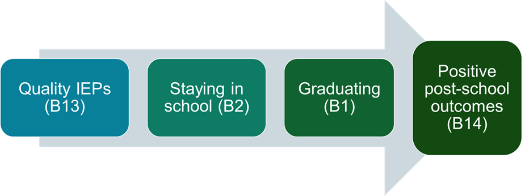Post-School Outcome Data
Post-School Outcome (PSO) data provide insights into education and employment activities for students who received special education services in high school
PSO Data and Indicator B14
Every state is required to report on their post-school outcomes (PSO) to the Office of Special Education Programs. Positive PSO are one of 17 performance indicators in the Individuals with Disabilities Education Act (IDEA).
There’s a critical relationship among the four performance indicators that relate to secondary transition. Research shows that quality IEPs (Indicator B13) lead to more students staying in school (Indicator B2), which leads to higher graduation rates (Indicator B1). Graduation is linked to positive outcomes for students after they’ve left high school (Indicator B14), such as engagement in continued education or employment.

These four indicators are also tied to the Local Education Agency (LEA) Application for Federal Funds for Special Education. Districts must develop plans to maintain or improve these indicators in their application.
State, ESD, and County PSO Data Reports
The data in these PSO reports can be used by schools and districts to evaluate the effectiveness of their special education programs and inform systems-change. The most recent data reflects the experiences of former students who permanently exited high school in the 2022-23 academic year. New reports are published in January each year.
View PSO Data Reports in Google Drive
OSPI Annual Performance Reports (APR)
Under the Individuals with Disabilities Education Act (IDEA), the OSPI Special Education Section is required to submit an APR to the Office of Special Education Programs (OSEP) that incorporates performance indicators, activities, and targets for each indicator. In addition, OSPI must report publicly each district's annual progress for indicators B1–B14. APRs for the last five years are available on OSPI's Special Education Data Collection web page.
Using PSO data to inform practice
PSO data are collected not only for state and federal reporting, but for continuous programmatic improvement.
School staff and other stakeholders use PSO data to inform practice around transition services including instruction, development of transition plans, activities, and agency collaboration. The goal is to increase engagement outcomes and decrease non-engagement.
PSO data are also tied to the Local Education Agency (LEA) Application for Federal Funds for Special Education. School districts must develop a plan to maintain or improve PSO in their application.
Request PSO Data
If you are a representative of a school, district, or ESD, please fill out the PSO Data Request Form and allow 10 business days for CCTS to process and complete your request.
Collecting PSO Data through the Post-School Survey
To gather PSO data from all former students who were receiving special education services at the time they exited high school, school districts conduct the annual Post-School Survey. Whether former students graduated, dropped out, or were expected to return but did not, their survey responses provide information about work and school activities within the first year of exiting high school.
Based on their survey responses, former students are categorized as Engaged or Not engaged in Higher Education, Competitive Employment, Other Education, or Other Employment.
CCTS offers technical support to school districts as they conduct the survey and provides state, ESD, county, and district-level data reports after the survey closes.